Cost Benefit Analysis of New Orleans: Reconstruction After Katrina
VerifiedAdded on 2020/05/16
|12
|2914
|44
Report
AI Summary
This report presents a cost-benefit analysis of the reconstruction of New Orleans following Hurricane Katrina in 2005. The analysis examines the economic conditions of New Orleans before and after the disaster, focusing on the impact on key sectors such as entertainment, transportation, and public service. It explores the costs and benefits of rebuilding, considering the perspectives of residents, the mayor, and the federal government. The report discusses the economic losses, unemployment, and the potential of restoring wetlands. It also considers the social and political effects on the population, including displacement, health issues, and government responses. The analysis concludes with a discussion on the controversies surrounding the rebuilding efforts, the role of government, and the factors influencing decisions about the city's future. This report provides valuable insights into the complexities of disaster recovery and economic evaluation in the aftermath of a major natural disaster.

Running head: COST BENEFIT ANALYSIS OF NEW ORLEANS
Cost benefit analysis of New Orleans
Name of the university
Name of the student
Author note
Cost benefit analysis of New Orleans
Name of the university
Name of the student
Author note
Secure Best Marks with AI Grader
Need help grading? Try our AI Grader for instant feedback on your assignments.
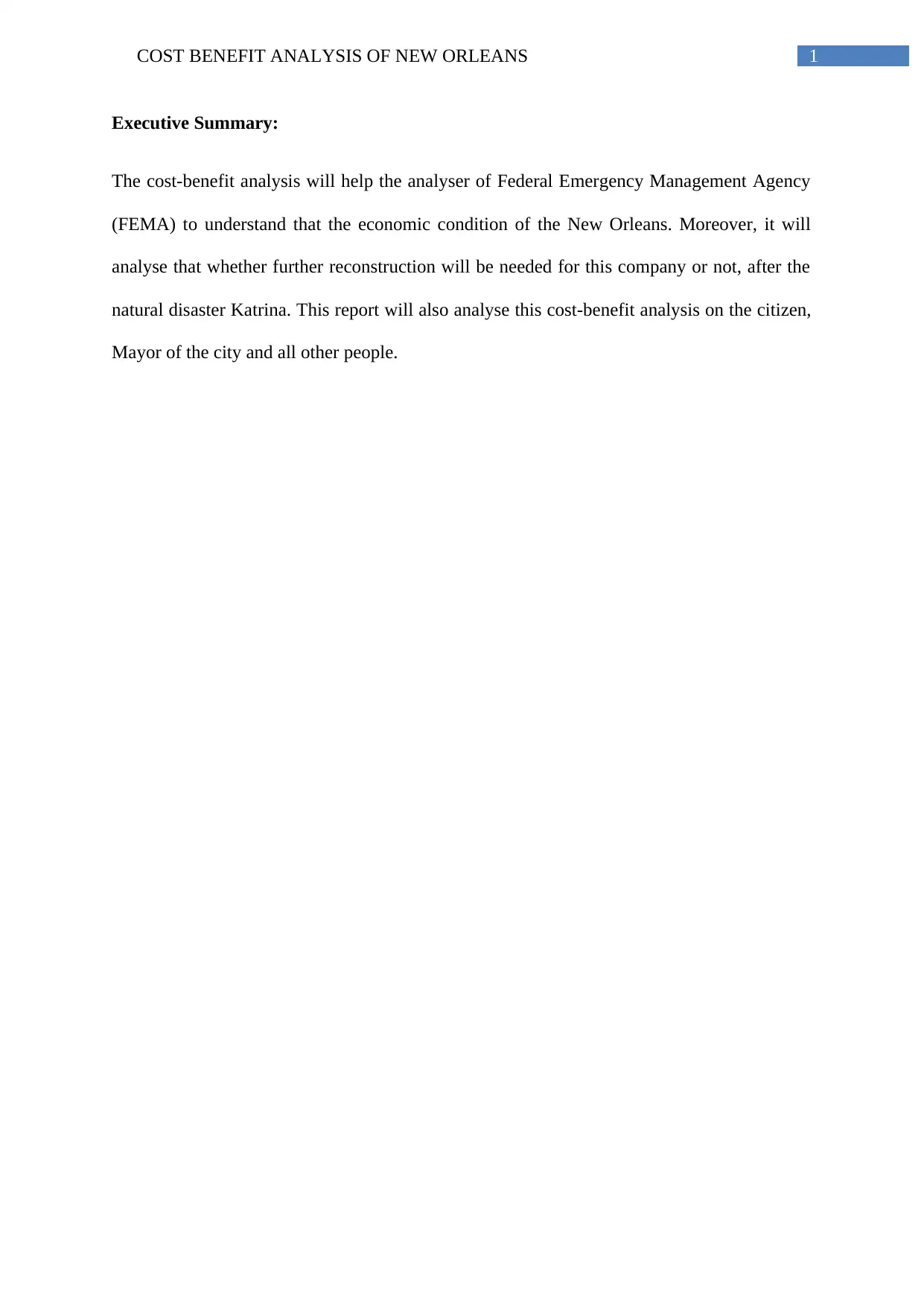
1COST BENEFIT ANALYSIS OF NEW ORLEANS
Executive Summary:
The cost-benefit analysis will help the analyser of Federal Emergency Management Agency
(FEMA) to understand that the economic condition of the New Orleans. Moreover, it will
analyse that whether further reconstruction will be needed for this company or not, after the
natural disaster Katrina. This report will also analyse this cost-benefit analysis on the citizen,
Mayor of the city and all other people.
Executive Summary:
The cost-benefit analysis will help the analyser of Federal Emergency Management Agency
(FEMA) to understand that the economic condition of the New Orleans. Moreover, it will
analyse that whether further reconstruction will be needed for this company or not, after the
natural disaster Katrina. This report will also analyse this cost-benefit analysis on the citizen,
Mayor of the city and all other people.
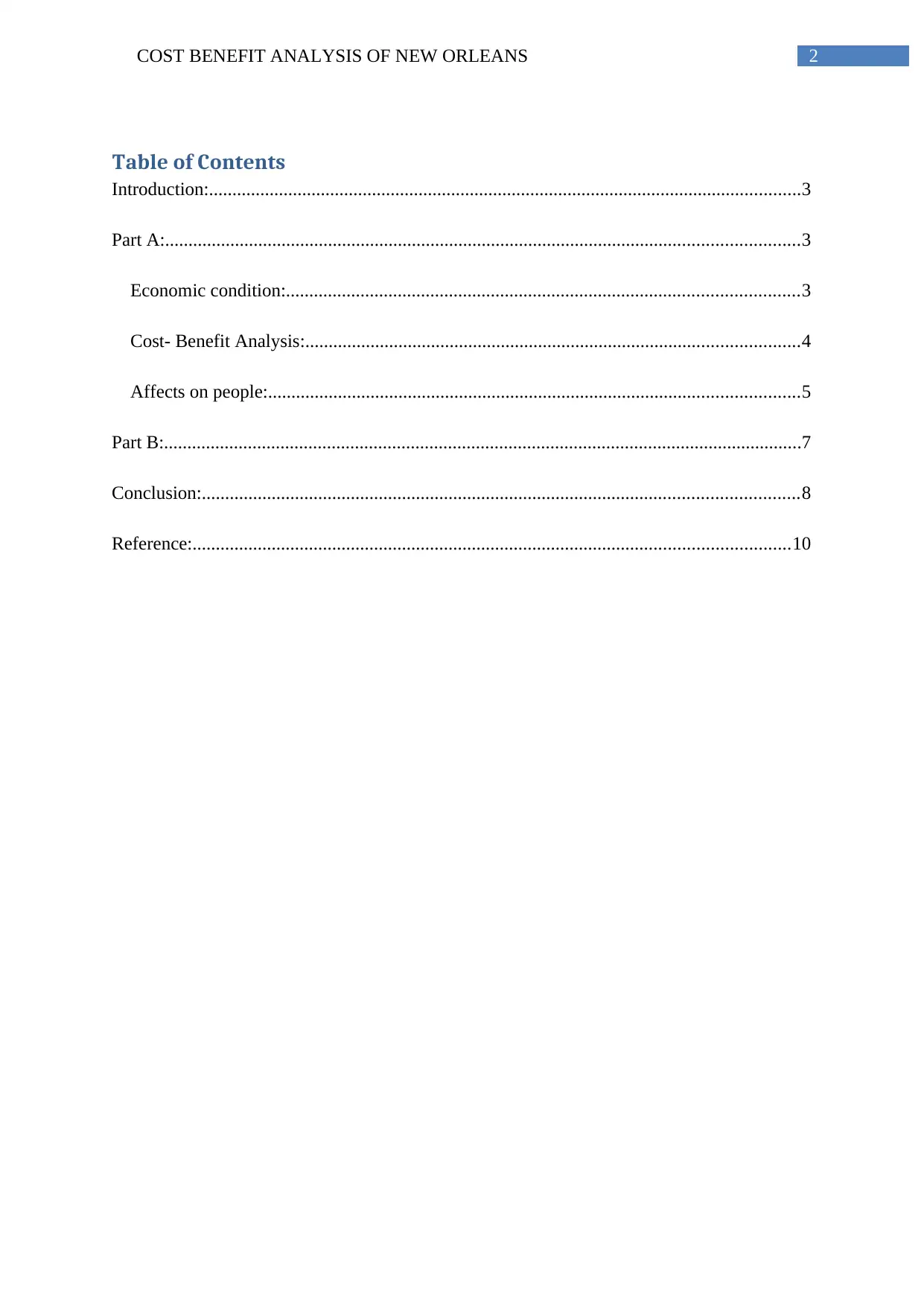
2COST BENEFIT ANALYSIS OF NEW ORLEANS
Table of Contents
Introduction:...............................................................................................................................3
Part A:........................................................................................................................................3
Economic condition:..............................................................................................................3
Cost- Benefit Analysis:..........................................................................................................4
Affects on people:..................................................................................................................5
Part B:.........................................................................................................................................7
Conclusion:................................................................................................................................8
Reference:................................................................................................................................10
Table of Contents
Introduction:...............................................................................................................................3
Part A:........................................................................................................................................3
Economic condition:..............................................................................................................3
Cost- Benefit Analysis:..........................................................................................................4
Affects on people:..................................................................................................................5
Part B:.........................................................................................................................................7
Conclusion:................................................................................................................................8
Reference:................................................................................................................................10
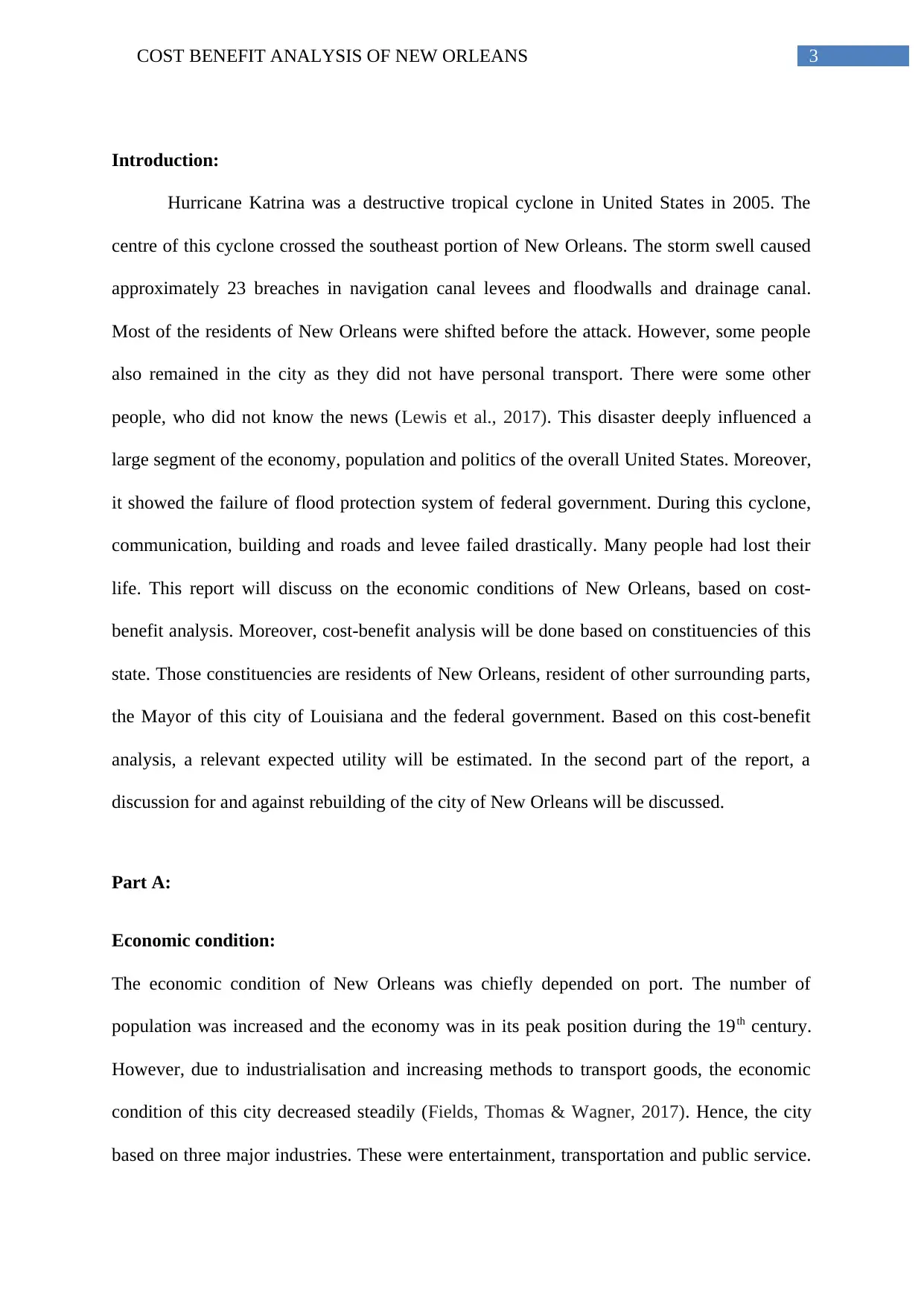
3COST BENEFIT ANALYSIS OF NEW ORLEANS
Introduction:
Hurricane Katrina was a destructive tropical cyclone in United States in 2005. The
centre of this cyclone crossed the southeast portion of New Orleans. The storm swell caused
approximately 23 breaches in navigation canal levees and floodwalls and drainage canal.
Most of the residents of New Orleans were shifted before the attack. However, some people
also remained in the city as they did not have personal transport. There were some other
people, who did not know the news (Lewis et al., 2017). This disaster deeply influenced a
large segment of the economy, population and politics of the overall United States. Moreover,
it showed the failure of flood protection system of federal government. During this cyclone,
communication, building and roads and levee failed drastically. Many people had lost their
life. This report will discuss on the economic conditions of New Orleans, based on cost-
benefit analysis. Moreover, cost-benefit analysis will be done based on constituencies of this
state. Those constituencies are residents of New Orleans, resident of other surrounding parts,
the Mayor of this city of Louisiana and the federal government. Based on this cost-benefit
analysis, a relevant expected utility will be estimated. In the second part of the report, a
discussion for and against rebuilding of the city of New Orleans will be discussed.
Part A:
Economic condition:
The economic condition of New Orleans was chiefly depended on port. The number of
population was increased and the economy was in its peak position during the 19th century.
However, due to industrialisation and increasing methods to transport goods, the economic
condition of this city decreased steadily (Fields, Thomas & Wagner, 2017). Hence, the city
based on three major industries. These were entertainment, transportation and public service.
Introduction:
Hurricane Katrina was a destructive tropical cyclone in United States in 2005. The
centre of this cyclone crossed the southeast portion of New Orleans. The storm swell caused
approximately 23 breaches in navigation canal levees and floodwalls and drainage canal.
Most of the residents of New Orleans were shifted before the attack. However, some people
also remained in the city as they did not have personal transport. There were some other
people, who did not know the news (Lewis et al., 2017). This disaster deeply influenced a
large segment of the economy, population and politics of the overall United States. Moreover,
it showed the failure of flood protection system of federal government. During this cyclone,
communication, building and roads and levee failed drastically. Many people had lost their
life. This report will discuss on the economic conditions of New Orleans, based on cost-
benefit analysis. Moreover, cost-benefit analysis will be done based on constituencies of this
state. Those constituencies are residents of New Orleans, resident of other surrounding parts,
the Mayor of this city of Louisiana and the federal government. Based on this cost-benefit
analysis, a relevant expected utility will be estimated. In the second part of the report, a
discussion for and against rebuilding of the city of New Orleans will be discussed.
Part A:
Economic condition:
The economic condition of New Orleans was chiefly depended on port. The number of
population was increased and the economy was in its peak position during the 19th century.
However, due to industrialisation and increasing methods to transport goods, the economic
condition of this city decreased steadily (Fields, Thomas & Wagner, 2017). Hence, the city
based on three major industries. These were entertainment, transportation and public service.
Secure Best Marks with AI Grader
Need help grading? Try our AI Grader for instant feedback on your assignments.
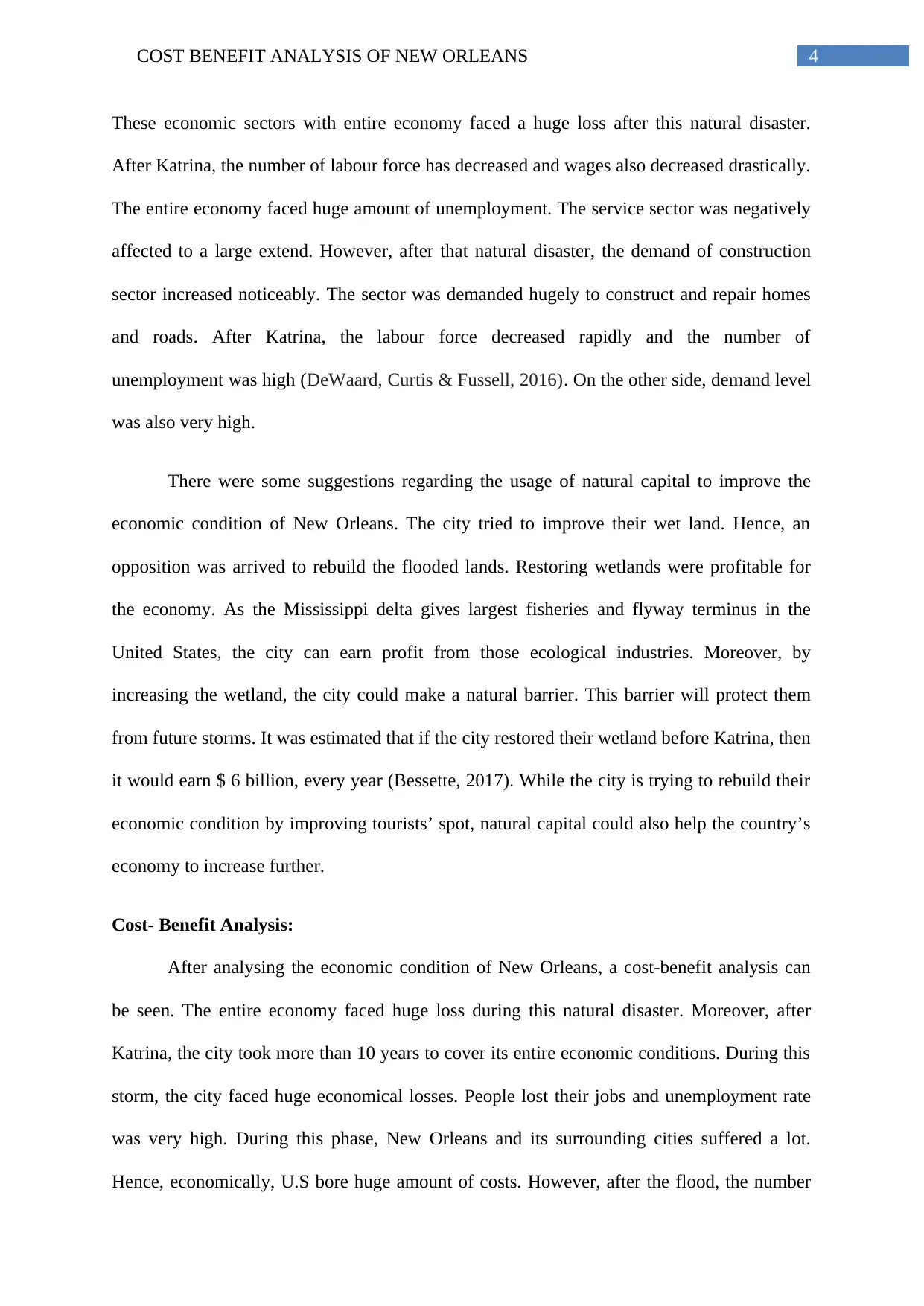
4COST BENEFIT ANALYSIS OF NEW ORLEANS
These economic sectors with entire economy faced a huge loss after this natural disaster.
After Katrina, the number of labour force has decreased and wages also decreased drastically.
The entire economy faced huge amount of unemployment. The service sector was negatively
affected to a large extend. However, after that natural disaster, the demand of construction
sector increased noticeably. The sector was demanded hugely to construct and repair homes
and roads. After Katrina, the labour force decreased rapidly and the number of
unemployment was high (DeWaard, Curtis & Fussell, 2016). On the other side, demand level
was also very high.
There were some suggestions regarding the usage of natural capital to improve the
economic condition of New Orleans. The city tried to improve their wet land. Hence, an
opposition was arrived to rebuild the flooded lands. Restoring wetlands were profitable for
the economy. As the Mississippi delta gives largest fisheries and flyway terminus in the
United States, the city can earn profit from those ecological industries. Moreover, by
increasing the wetland, the city could make a natural barrier. This barrier will protect them
from future storms. It was estimated that if the city restored their wetland before Katrina, then
it would earn $ 6 billion, every year (Bessette, 2017). While the city is trying to rebuild their
economic condition by improving tourists’ spot, natural capital could also help the country’s
economy to increase further.
Cost- Benefit Analysis:
After analysing the economic condition of New Orleans, a cost-benefit analysis can
be seen. The entire economy faced huge loss during this natural disaster. Moreover, after
Katrina, the city took more than 10 years to cover its entire economic conditions. During this
storm, the city faced huge economical losses. People lost their jobs and unemployment rate
was very high. During this phase, New Orleans and its surrounding cities suffered a lot.
Hence, economically, U.S bore huge amount of costs. However, after the flood, the number
These economic sectors with entire economy faced a huge loss after this natural disaster.
After Katrina, the number of labour force has decreased and wages also decreased drastically.
The entire economy faced huge amount of unemployment. The service sector was negatively
affected to a large extend. However, after that natural disaster, the demand of construction
sector increased noticeably. The sector was demanded hugely to construct and repair homes
and roads. After Katrina, the labour force decreased rapidly and the number of
unemployment was high (DeWaard, Curtis & Fussell, 2016). On the other side, demand level
was also very high.
There were some suggestions regarding the usage of natural capital to improve the
economic condition of New Orleans. The city tried to improve their wet land. Hence, an
opposition was arrived to rebuild the flooded lands. Restoring wetlands were profitable for
the economy. As the Mississippi delta gives largest fisheries and flyway terminus in the
United States, the city can earn profit from those ecological industries. Moreover, by
increasing the wetland, the city could make a natural barrier. This barrier will protect them
from future storms. It was estimated that if the city restored their wetland before Katrina, then
it would earn $ 6 billion, every year (Bessette, 2017). While the city is trying to rebuild their
economic condition by improving tourists’ spot, natural capital could also help the country’s
economy to increase further.
Cost- Benefit Analysis:
After analysing the economic condition of New Orleans, a cost-benefit analysis can
be seen. The entire economy faced huge loss during this natural disaster. Moreover, after
Katrina, the city took more than 10 years to cover its entire economic conditions. During this
storm, the city faced huge economical losses. People lost their jobs and unemployment rate
was very high. During this phase, New Orleans and its surrounding cities suffered a lot.
Hence, economically, U.S bore huge amount of costs. However, after the flood, the number
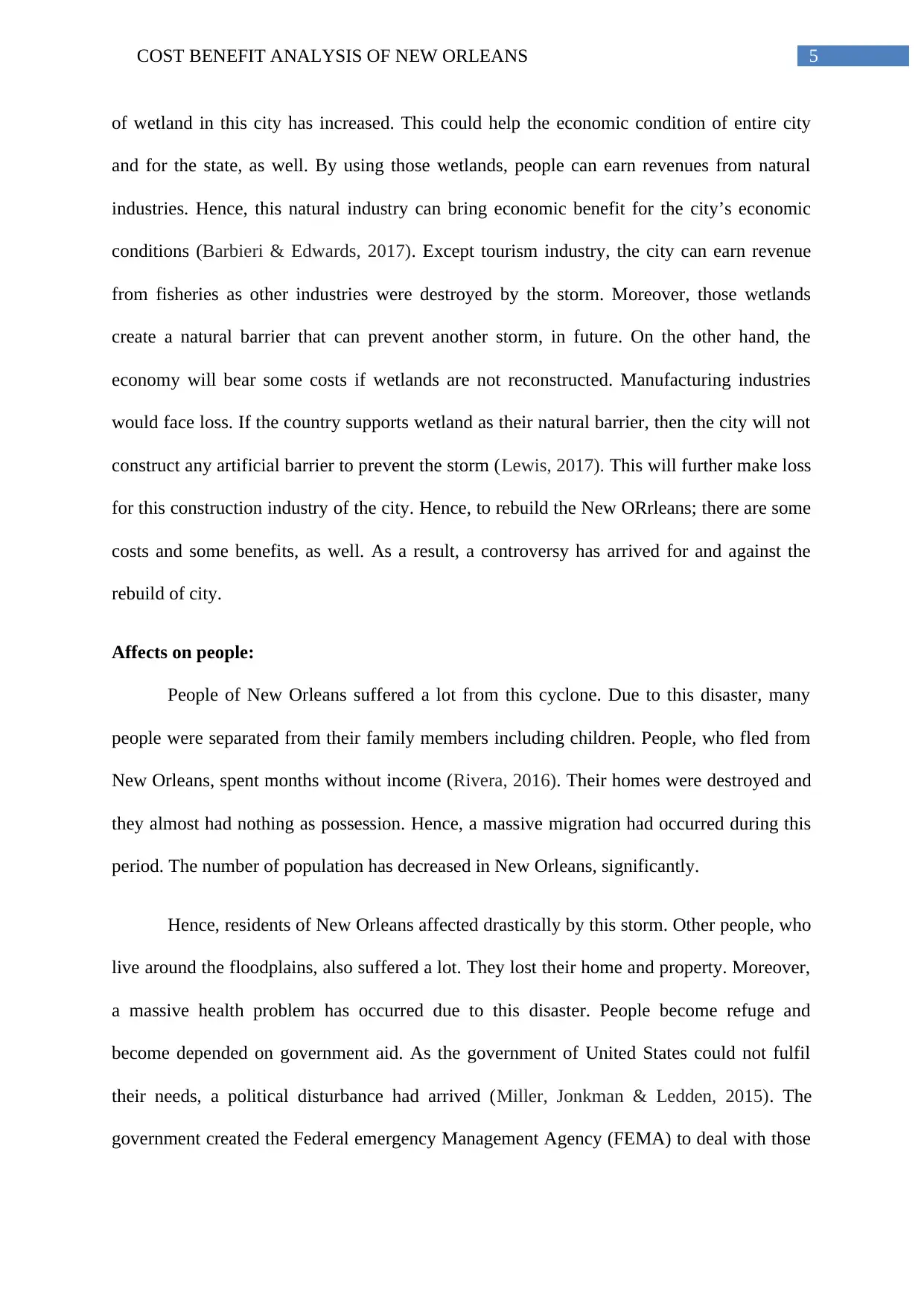
5COST BENEFIT ANALYSIS OF NEW ORLEANS
of wetland in this city has increased. This could help the economic condition of entire city
and for the state, as well. By using those wetlands, people can earn revenues from natural
industries. Hence, this natural industry can bring economic benefit for the city’s economic
conditions (Barbieri & Edwards, 2017). Except tourism industry, the city can earn revenue
from fisheries as other industries were destroyed by the storm. Moreover, those wetlands
create a natural barrier that can prevent another storm, in future. On the other hand, the
economy will bear some costs if wetlands are not reconstructed. Manufacturing industries
would face loss. If the country supports wetland as their natural barrier, then the city will not
construct any artificial barrier to prevent the storm (Lewis, 2017). This will further make loss
for this construction industry of the city. Hence, to rebuild the New ORrleans; there are some
costs and some benefits, as well. As a result, a controversy has arrived for and against the
rebuild of city.
Affects on people:
People of New Orleans suffered a lot from this cyclone. Due to this disaster, many
people were separated from their family members including children. People, who fled from
New Orleans, spent months without income (Rivera, 2016). Their homes were destroyed and
they almost had nothing as possession. Hence, a massive migration had occurred during this
period. The number of population has decreased in New Orleans, significantly.
Hence, residents of New Orleans affected drastically by this storm. Other people, who
live around the floodplains, also suffered a lot. They lost their home and property. Moreover,
a massive health problem has occurred due to this disaster. People become refuge and
become depended on government aid. As the government of United States could not fulfil
their needs, a political disturbance had arrived (Miller, Jonkman & Ledden, 2015). The
government created the Federal emergency Management Agency (FEMA) to deal with those
of wetland in this city has increased. This could help the economic condition of entire city
and for the state, as well. By using those wetlands, people can earn revenues from natural
industries. Hence, this natural industry can bring economic benefit for the city’s economic
conditions (Barbieri & Edwards, 2017). Except tourism industry, the city can earn revenue
from fisheries as other industries were destroyed by the storm. Moreover, those wetlands
create a natural barrier that can prevent another storm, in future. On the other hand, the
economy will bear some costs if wetlands are not reconstructed. Manufacturing industries
would face loss. If the country supports wetland as their natural barrier, then the city will not
construct any artificial barrier to prevent the storm (Lewis, 2017). This will further make loss
for this construction industry of the city. Hence, to rebuild the New ORrleans; there are some
costs and some benefits, as well. As a result, a controversy has arrived for and against the
rebuild of city.
Affects on people:
People of New Orleans suffered a lot from this cyclone. Due to this disaster, many
people were separated from their family members including children. People, who fled from
New Orleans, spent months without income (Rivera, 2016). Their homes were destroyed and
they almost had nothing as possession. Hence, a massive migration had occurred during this
period. The number of population has decreased in New Orleans, significantly.
Hence, residents of New Orleans affected drastically by this storm. Other people, who
live around the floodplains, also suffered a lot. They lost their home and property. Moreover,
a massive health problem has occurred due to this disaster. People become refuge and
become depended on government aid. As the government of United States could not fulfil
their needs, a political disturbance had arrived (Miller, Jonkman & Ledden, 2015). The
government created the Federal emergency Management Agency (FEMA) to deal with those
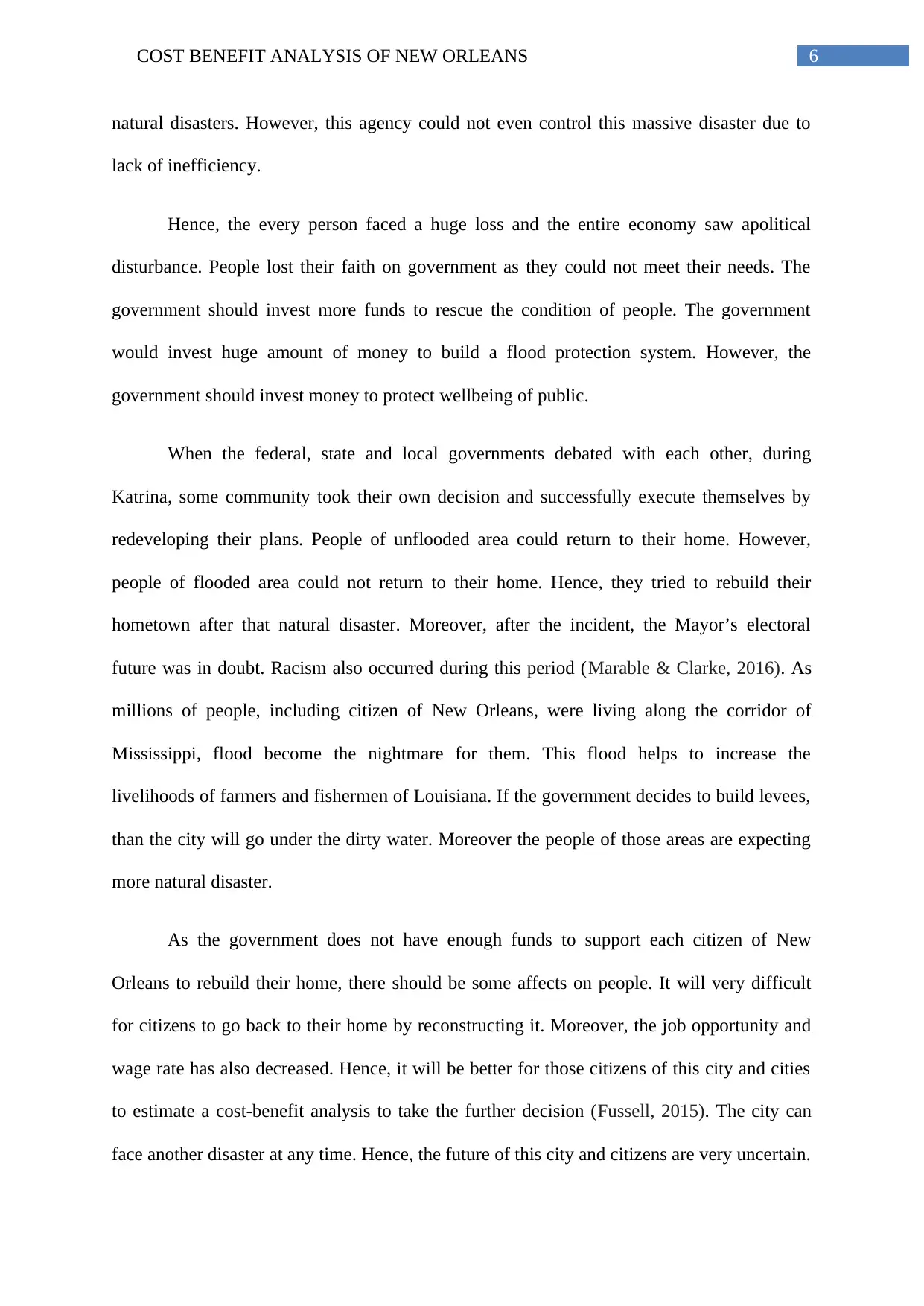
6COST BENEFIT ANALYSIS OF NEW ORLEANS
natural disasters. However, this agency could not even control this massive disaster due to
lack of inefficiency.
Hence, the every person faced a huge loss and the entire economy saw apolitical
disturbance. People lost their faith on government as they could not meet their needs. The
government should invest more funds to rescue the condition of people. The government
would invest huge amount of money to build a flood protection system. However, the
government should invest money to protect wellbeing of public.
When the federal, state and local governments debated with each other, during
Katrina, some community took their own decision and successfully execute themselves by
redeveloping their plans. People of unflooded area could return to their home. However,
people of flooded area could not return to their home. Hence, they tried to rebuild their
hometown after that natural disaster. Moreover, after the incident, the Mayor’s electoral
future was in doubt. Racism also occurred during this period (Marable & Clarke, 2016). As
millions of people, including citizen of New Orleans, were living along the corridor of
Mississippi, flood become the nightmare for them. This flood helps to increase the
livelihoods of farmers and fishermen of Louisiana. If the government decides to build levees,
than the city will go under the dirty water. Moreover the people of those areas are expecting
more natural disaster.
As the government does not have enough funds to support each citizen of New
Orleans to rebuild their home, there should be some affects on people. It will very difficult
for citizens to go back to their home by reconstructing it. Moreover, the job opportunity and
wage rate has also decreased. Hence, it will be better for those citizens of this city and cities
to estimate a cost-benefit analysis to take the further decision (Fussell, 2015). The city can
face another disaster at any time. Hence, the future of this city and citizens are very uncertain.
natural disasters. However, this agency could not even control this massive disaster due to
lack of inefficiency.
Hence, the every person faced a huge loss and the entire economy saw apolitical
disturbance. People lost their faith on government as they could not meet their needs. The
government should invest more funds to rescue the condition of people. The government
would invest huge amount of money to build a flood protection system. However, the
government should invest money to protect wellbeing of public.
When the federal, state and local governments debated with each other, during
Katrina, some community took their own decision and successfully execute themselves by
redeveloping their plans. People of unflooded area could return to their home. However,
people of flooded area could not return to their home. Hence, they tried to rebuild their
hometown after that natural disaster. Moreover, after the incident, the Mayor’s electoral
future was in doubt. Racism also occurred during this period (Marable & Clarke, 2016). As
millions of people, including citizen of New Orleans, were living along the corridor of
Mississippi, flood become the nightmare for them. This flood helps to increase the
livelihoods of farmers and fishermen of Louisiana. If the government decides to build levees,
than the city will go under the dirty water. Moreover the people of those areas are expecting
more natural disaster.
As the government does not have enough funds to support each citizen of New
Orleans to rebuild their home, there should be some affects on people. It will very difficult
for citizens to go back to their home by reconstructing it. Moreover, the job opportunity and
wage rate has also decreased. Hence, it will be better for those citizens of this city and cities
to estimate a cost-benefit analysis to take the further decision (Fussell, 2015). The city can
face another disaster at any time. Hence, the future of this city and citizens are very uncertain.
Paraphrase This Document
Need a fresh take? Get an instant paraphrase of this document with our AI Paraphraser
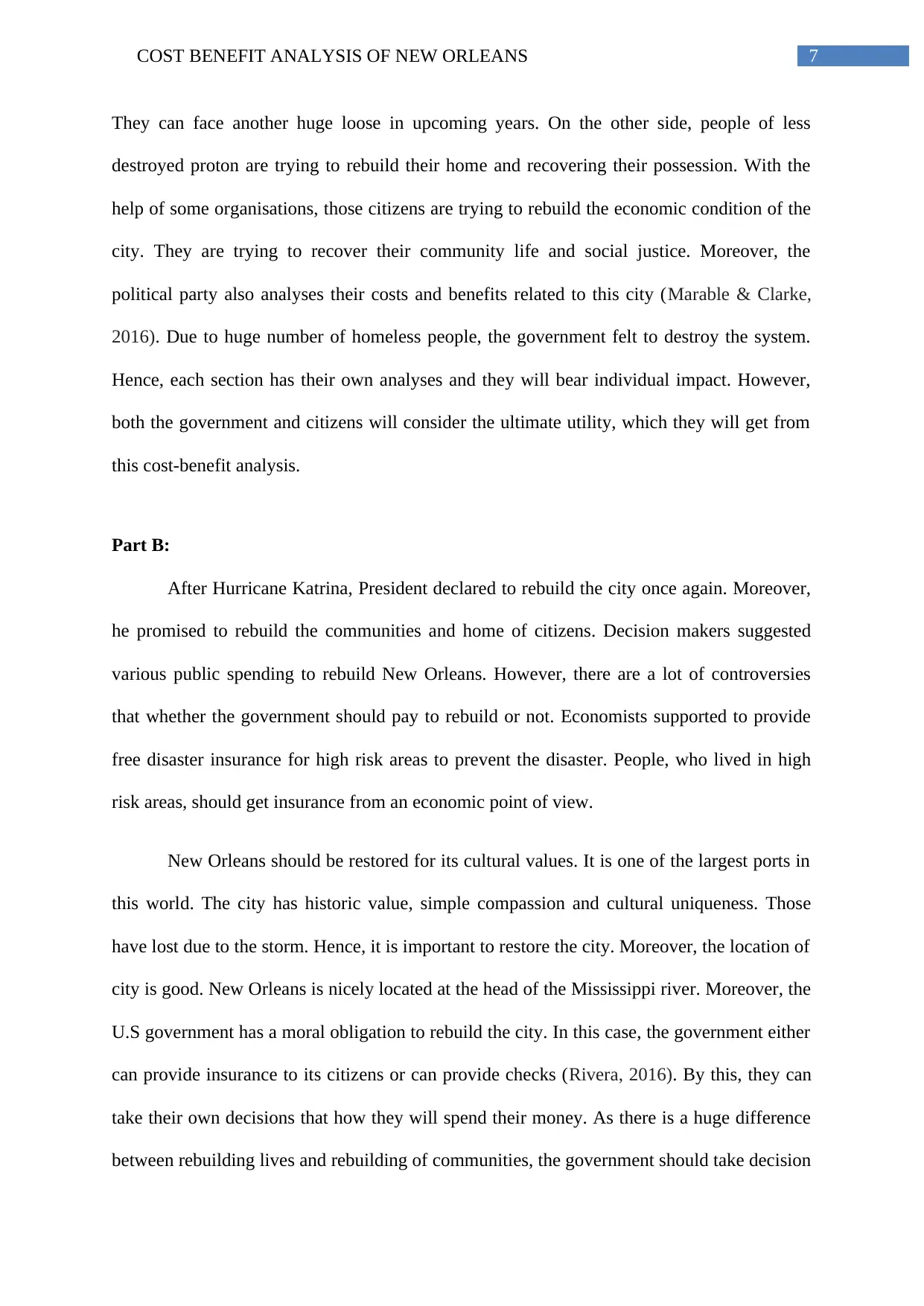
7COST BENEFIT ANALYSIS OF NEW ORLEANS
They can face another huge loose in upcoming years. On the other side, people of less
destroyed proton are trying to rebuild their home and recovering their possession. With the
help of some organisations, those citizens are trying to rebuild the economic condition of the
city. They are trying to recover their community life and social justice. Moreover, the
political party also analyses their costs and benefits related to this city (Marable & Clarke,
2016). Due to huge number of homeless people, the government felt to destroy the system.
Hence, each section has their own analyses and they will bear individual impact. However,
both the government and citizens will consider the ultimate utility, which they will get from
this cost-benefit analysis.
Part B:
After Hurricane Katrina, President declared to rebuild the city once again. Moreover,
he promised to rebuild the communities and home of citizens. Decision makers suggested
various public spending to rebuild New Orleans. However, there are a lot of controversies
that whether the government should pay to rebuild or not. Economists supported to provide
free disaster insurance for high risk areas to prevent the disaster. People, who lived in high
risk areas, should get insurance from an economic point of view.
New Orleans should be restored for its cultural values. It is one of the largest ports in
this world. The city has historic value, simple compassion and cultural uniqueness. Those
have lost due to the storm. Hence, it is important to restore the city. Moreover, the location of
city is good. New Orleans is nicely located at the head of the Mississippi river. Moreover, the
U.S government has a moral obligation to rebuild the city. In this case, the government either
can provide insurance to its citizens or can provide checks (Rivera, 2016). By this, they can
take their own decisions that how they will spend their money. As there is a huge difference
between rebuilding lives and rebuilding of communities, the government should take decision
They can face another huge loose in upcoming years. On the other side, people of less
destroyed proton are trying to rebuild their home and recovering their possession. With the
help of some organisations, those citizens are trying to rebuild the economic condition of the
city. They are trying to recover their community life and social justice. Moreover, the
political party also analyses their costs and benefits related to this city (Marable & Clarke,
2016). Due to huge number of homeless people, the government felt to destroy the system.
Hence, each section has their own analyses and they will bear individual impact. However,
both the government and citizens will consider the ultimate utility, which they will get from
this cost-benefit analysis.
Part B:
After Hurricane Katrina, President declared to rebuild the city once again. Moreover,
he promised to rebuild the communities and home of citizens. Decision makers suggested
various public spending to rebuild New Orleans. However, there are a lot of controversies
that whether the government should pay to rebuild or not. Economists supported to provide
free disaster insurance for high risk areas to prevent the disaster. People, who lived in high
risk areas, should get insurance from an economic point of view.
New Orleans should be restored for its cultural values. It is one of the largest ports in
this world. The city has historic value, simple compassion and cultural uniqueness. Those
have lost due to the storm. Hence, it is important to restore the city. Moreover, the location of
city is good. New Orleans is nicely located at the head of the Mississippi river. Moreover, the
U.S government has a moral obligation to rebuild the city. In this case, the government either
can provide insurance to its citizens or can provide checks (Rivera, 2016). By this, they can
take their own decisions that how they will spend their money. As there is a huge difference
between rebuilding lives and rebuilding of communities, the government should take decision
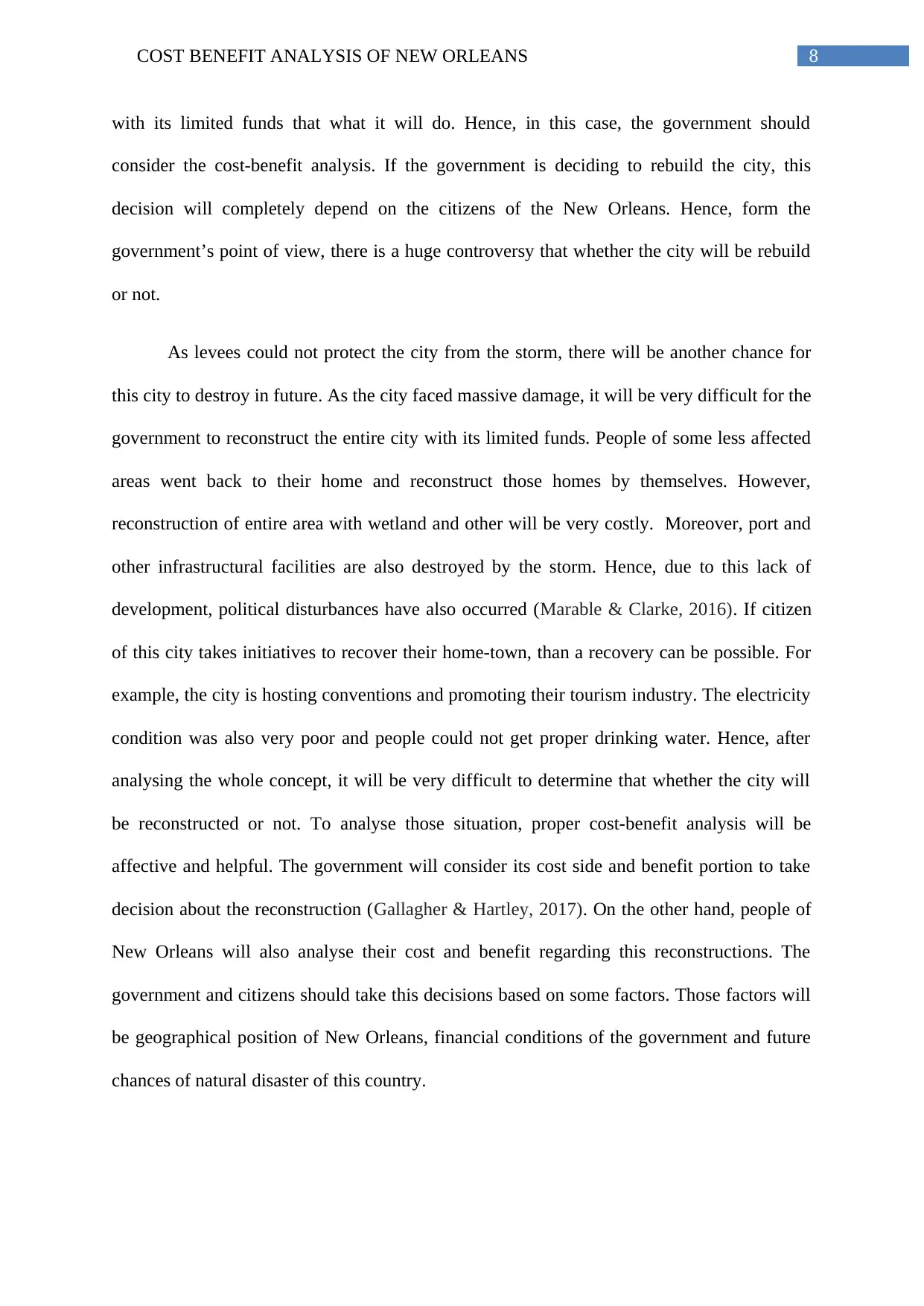
8COST BENEFIT ANALYSIS OF NEW ORLEANS
with its limited funds that what it will do. Hence, in this case, the government should
consider the cost-benefit analysis. If the government is deciding to rebuild the city, this
decision will completely depend on the citizens of the New Orleans. Hence, form the
government’s point of view, there is a huge controversy that whether the city will be rebuild
or not.
As levees could not protect the city from the storm, there will be another chance for
this city to destroy in future. As the city faced massive damage, it will be very difficult for the
government to reconstruct the entire city with its limited funds. People of some less affected
areas went back to their home and reconstruct those homes by themselves. However,
reconstruction of entire area with wetland and other will be very costly. Moreover, port and
other infrastructural facilities are also destroyed by the storm. Hence, due to this lack of
development, political disturbances have also occurred (Marable & Clarke, 2016). If citizen
of this city takes initiatives to recover their home-town, than a recovery can be possible. For
example, the city is hosting conventions and promoting their tourism industry. The electricity
condition was also very poor and people could not get proper drinking water. Hence, after
analysing the whole concept, it will be very difficult to determine that whether the city will
be reconstructed or not. To analyse those situation, proper cost-benefit analysis will be
affective and helpful. The government will consider its cost side and benefit portion to take
decision about the reconstruction (Gallagher & Hartley, 2017). On the other hand, people of
New Orleans will also analyse their cost and benefit regarding this reconstructions. The
government and citizens should take this decisions based on some factors. Those factors will
be geographical position of New Orleans, financial conditions of the government and future
chances of natural disaster of this country.
with its limited funds that what it will do. Hence, in this case, the government should
consider the cost-benefit analysis. If the government is deciding to rebuild the city, this
decision will completely depend on the citizens of the New Orleans. Hence, form the
government’s point of view, there is a huge controversy that whether the city will be rebuild
or not.
As levees could not protect the city from the storm, there will be another chance for
this city to destroy in future. As the city faced massive damage, it will be very difficult for the
government to reconstruct the entire city with its limited funds. People of some less affected
areas went back to their home and reconstruct those homes by themselves. However,
reconstruction of entire area with wetland and other will be very costly. Moreover, port and
other infrastructural facilities are also destroyed by the storm. Hence, due to this lack of
development, political disturbances have also occurred (Marable & Clarke, 2016). If citizen
of this city takes initiatives to recover their home-town, than a recovery can be possible. For
example, the city is hosting conventions and promoting their tourism industry. The electricity
condition was also very poor and people could not get proper drinking water. Hence, after
analysing the whole concept, it will be very difficult to determine that whether the city will
be reconstructed or not. To analyse those situation, proper cost-benefit analysis will be
affective and helpful. The government will consider its cost side and benefit portion to take
decision about the reconstruction (Gallagher & Hartley, 2017). On the other hand, people of
New Orleans will also analyse their cost and benefit regarding this reconstructions. The
government and citizens should take this decisions based on some factors. Those factors will
be geographical position of New Orleans, financial conditions of the government and future
chances of natural disaster of this country.
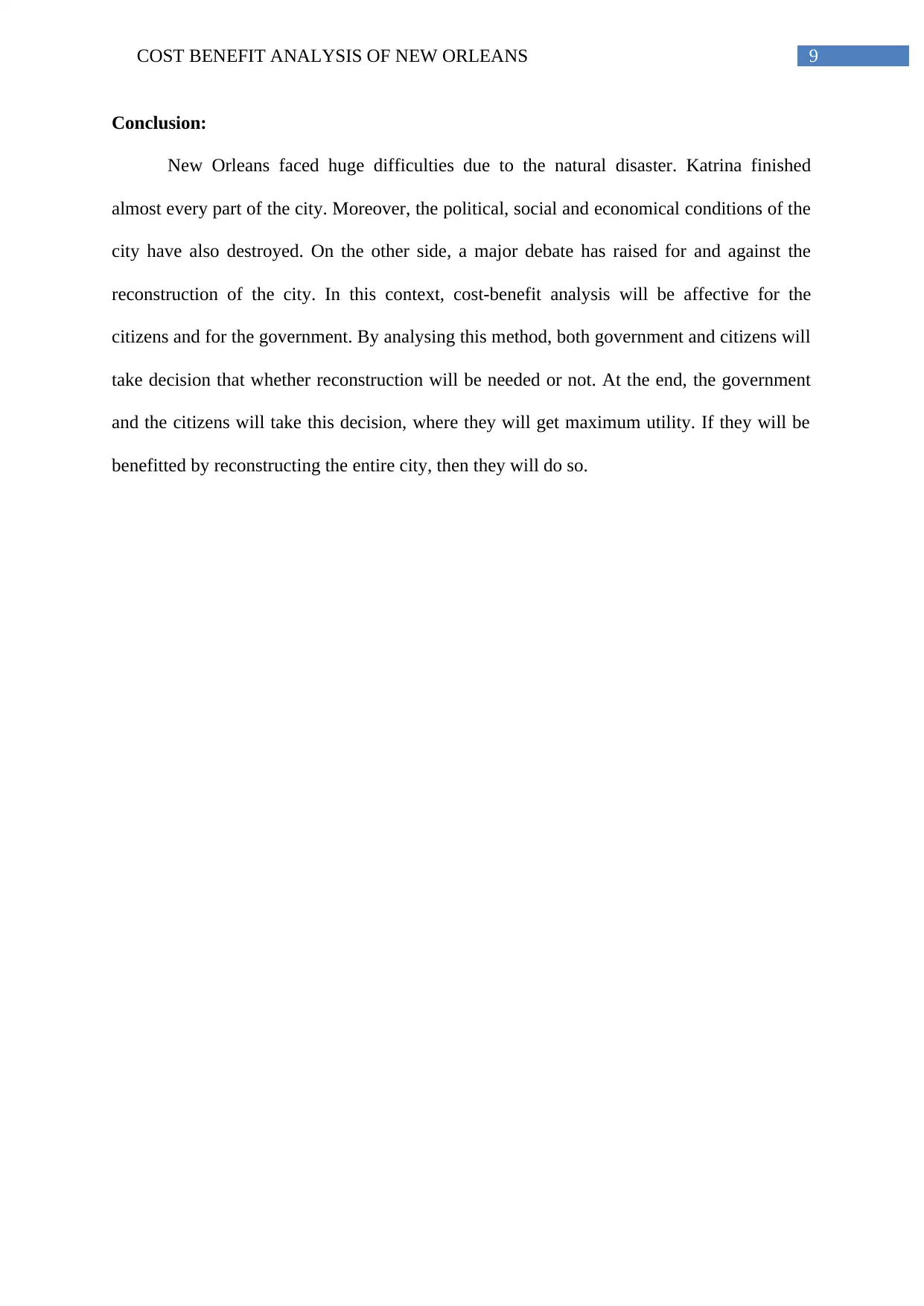
9COST BENEFIT ANALYSIS OF NEW ORLEANS
Conclusion:
New Orleans faced huge difficulties due to the natural disaster. Katrina finished
almost every part of the city. Moreover, the political, social and economical conditions of the
city have also destroyed. On the other side, a major debate has raised for and against the
reconstruction of the city. In this context, cost-benefit analysis will be affective for the
citizens and for the government. By analysing this method, both government and citizens will
take decision that whether reconstruction will be needed or not. At the end, the government
and the citizens will take this decision, where they will get maximum utility. If they will be
benefitted by reconstructing the entire city, then they will do so.
Conclusion:
New Orleans faced huge difficulties due to the natural disaster. Katrina finished
almost every part of the city. Moreover, the political, social and economical conditions of the
city have also destroyed. On the other side, a major debate has raised for and against the
reconstruction of the city. In this context, cost-benefit analysis will be affective for the
citizens and for the government. By analysing this method, both government and citizens will
take decision that whether reconstruction will be needed or not. At the end, the government
and the citizens will take this decision, where they will get maximum utility. If they will be
benefitted by reconstructing the entire city, then they will do so.
Secure Best Marks with AI Grader
Need help grading? Try our AI Grader for instant feedback on your assignments.
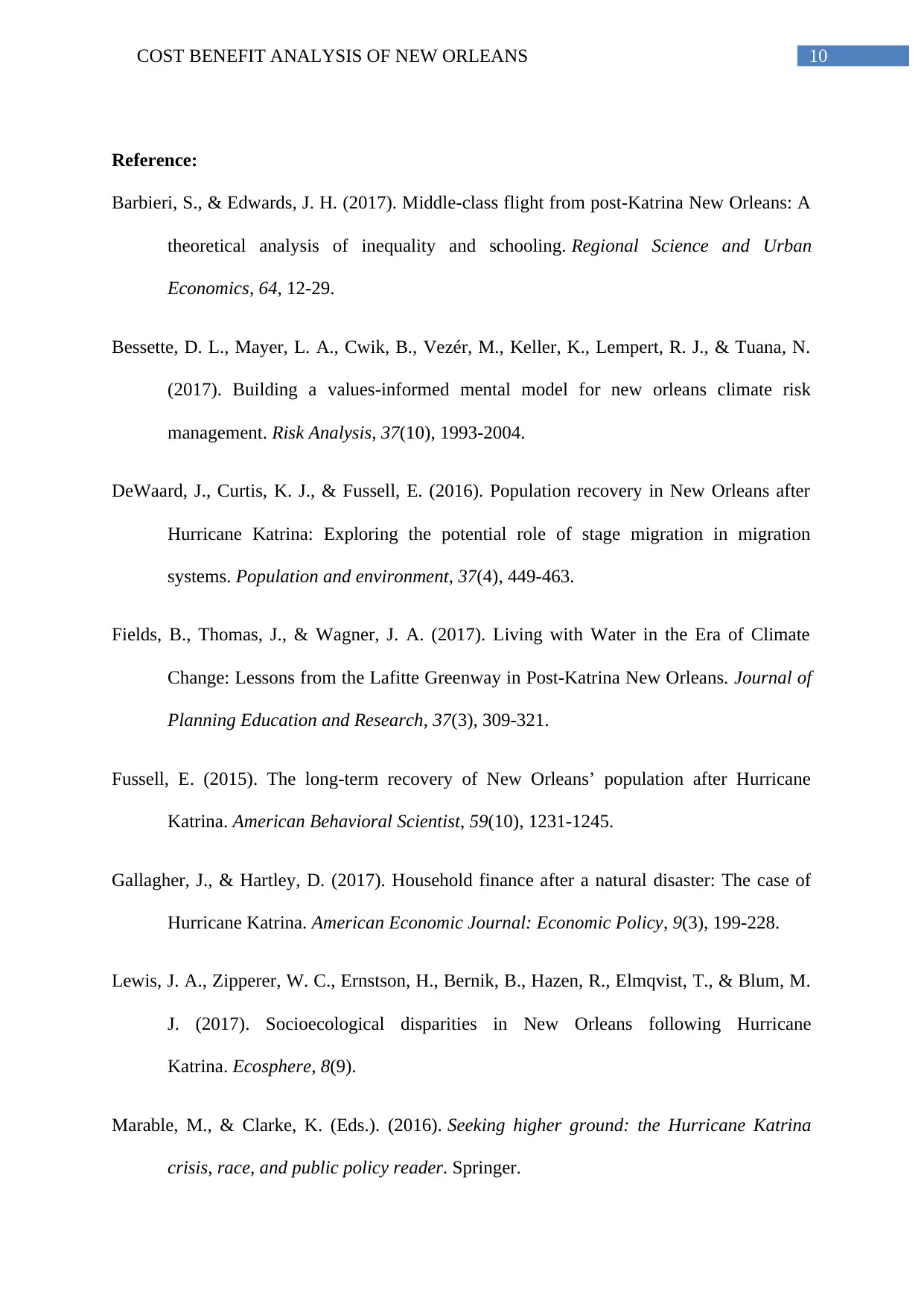
10COST BENEFIT ANALYSIS OF NEW ORLEANS
Reference:
Barbieri, S., & Edwards, J. H. (2017). Middle-class flight from post-Katrina New Orleans: A
theoretical analysis of inequality and schooling. Regional Science and Urban
Economics, 64, 12-29.
Bessette, D. L., Mayer, L. A., Cwik, B., Vezér, M., Keller, K., Lempert, R. J., & Tuana, N.
(2017). Building a values‐informed mental model for new orleans climate risk
management. Risk Analysis, 37(10), 1993-2004.
DeWaard, J., Curtis, K. J., & Fussell, E. (2016). Population recovery in New Orleans after
Hurricane Katrina: Exploring the potential role of stage migration in migration
systems. Population and environment, 37(4), 449-463.
Fields, B., Thomas, J., & Wagner, J. A. (2017). Living with Water in the Era of Climate
Change: Lessons from the Lafitte Greenway in Post-Katrina New Orleans. Journal of
Planning Education and Research, 37(3), 309-321.
Fussell, E. (2015). The long-term recovery of New Orleans’ population after Hurricane
Katrina. American Behavioral Scientist, 59(10), 1231-1245.
Gallagher, J., & Hartley, D. (2017). Household finance after a natural disaster: The case of
Hurricane Katrina. American Economic Journal: Economic Policy, 9(3), 199-228.
Lewis, J. A., Zipperer, W. C., Ernstson, H., Bernik, B., Hazen, R., Elmqvist, T., & Blum, M.
J. (2017). Socioecological disparities in New Orleans following Hurricane
Katrina. Ecosphere, 8(9).
Marable, M., & Clarke, K. (Eds.). (2016). Seeking higher ground: the Hurricane Katrina
crisis, race, and public policy reader. Springer.
Reference:
Barbieri, S., & Edwards, J. H. (2017). Middle-class flight from post-Katrina New Orleans: A
theoretical analysis of inequality and schooling. Regional Science and Urban
Economics, 64, 12-29.
Bessette, D. L., Mayer, L. A., Cwik, B., Vezér, M., Keller, K., Lempert, R. J., & Tuana, N.
(2017). Building a values‐informed mental model for new orleans climate risk
management. Risk Analysis, 37(10), 1993-2004.
DeWaard, J., Curtis, K. J., & Fussell, E. (2016). Population recovery in New Orleans after
Hurricane Katrina: Exploring the potential role of stage migration in migration
systems. Population and environment, 37(4), 449-463.
Fields, B., Thomas, J., & Wagner, J. A. (2017). Living with Water in the Era of Climate
Change: Lessons from the Lafitte Greenway in Post-Katrina New Orleans. Journal of
Planning Education and Research, 37(3), 309-321.
Fussell, E. (2015). The long-term recovery of New Orleans’ population after Hurricane
Katrina. American Behavioral Scientist, 59(10), 1231-1245.
Gallagher, J., & Hartley, D. (2017). Household finance after a natural disaster: The case of
Hurricane Katrina. American Economic Journal: Economic Policy, 9(3), 199-228.
Lewis, J. A., Zipperer, W. C., Ernstson, H., Bernik, B., Hazen, R., Elmqvist, T., & Blum, M.
J. (2017). Socioecological disparities in New Orleans following Hurricane
Katrina. Ecosphere, 8(9).
Marable, M., & Clarke, K. (Eds.). (2016). Seeking higher ground: the Hurricane Katrina
crisis, race, and public policy reader. Springer.

11COST BENEFIT ANALYSIS OF NEW ORLEANS
Miller, A., Jonkman, S. N., & Ledden, M. V. (2015). Risk to life due to flooding in post-
Katrina New Orleans. Natural hazards and earth system sciences, 15(1), 59-73.
Rivera, J. D. (2016). Disaster's Impact on Livelihood and Cultural Survival: Losses,
Opportunities, and Mitigation by Michèle Companion (Ed.). Risk, Hazards & Crisis
in Public Policy, 7(3), 146-155.
Miller, A., Jonkman, S. N., & Ledden, M. V. (2015). Risk to life due to flooding in post-
Katrina New Orleans. Natural hazards and earth system sciences, 15(1), 59-73.
Rivera, J. D. (2016). Disaster's Impact on Livelihood and Cultural Survival: Losses,
Opportunities, and Mitigation by Michèle Companion (Ed.). Risk, Hazards & Crisis
in Public Policy, 7(3), 146-155.
1 out of 12
Your All-in-One AI-Powered Toolkit for Academic Success.
+13062052269
info@desklib.com
Available 24*7 on WhatsApp / Email
![[object Object]](/_next/static/media/star-bottom.7253800d.svg)
Unlock your academic potential
© 2024 | Zucol Services PVT LTD | All rights reserved.
